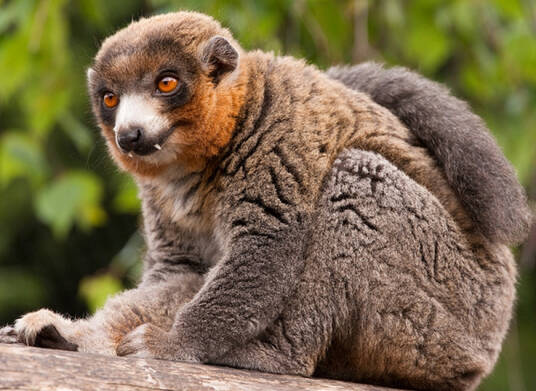Eulemur mongoz
IUCN
LCBasic Information
Scientific classification
- name:Eulemur mongoz
- Scientific Name:Eulemur mongoz,Mongoose Lemur,Mongoose lemur
- Outline:Primates
- Family:Lemuridae Lemuridae
Vital signs
- length:30-35cm
- Weight:1.1-1.6kg
- lifetime:No verification information
Feature
The fur is dense and long, broom-shaped, and the eyes are reddish orange.
Distribution and Habitat
The range of the mongoose is restricted to northwestern Madagascar, and is also found on the Comoros Islands of Moheli and Anjouan, with some individuals also present in the Greater Comoros.
Lives inland, habitats include dry deciduous broadleaf forests and secondary forests. In the Comoros, this arboreal species lives in moist forests.
Appearance
The mongoose is the smallest species in the genus Lemur. The head and body are 30-35 cm long, the tail is 45-48 cm long, and the weight is 1.1-1.6 kg. It has soft fur. The tail is longer than the body, and the hair is dense and long, broom-shaped; the eyes are large; the fur is dense and brightly colored; the snout is elongated, shaped like a fox's mouth; the outer ear shell is semicircular; the hind limbs are longer than the front limbs, the fingers and toes have flat nails, and the second toe has a grooved and curved claw; there are 36 teeth, and the upper incisors are missing.
The color of the upper body ranges from brown to yellow or black, the dorsal fur is a unique reddish brown, and the ventral fur is grayish white. The tail is darker in color, the face is slightly black, the muzzle and crown are usually dark, from dark gray to black, and there are whiskers around the face, forehead and back of the neck. The lower body is slightly gray or cream gray. Pale grey-brown fur
Details
Mongoose Lemur (scientific name: Eulemur mongoz) is called Mongoose Lemur in foreign language. It has no subspecies and is a medium-sized lemur.

The activity pattern of the Eulemur mongoz changes with the seasons, making it very different from most other primates. Behavior varies greatly throughout the wet and dry seasons. In the dry season, they tend to be more nocturnal, but after the rainy season, they become more diurnal or crepuscular. They feed on fruit throughout the year, but also on flowers when they are in bloom, especially flowers from the Kapok tree, which are also eaten in the rainy season. These lemurs love nectar. In the dry season, they supplement with mature and immature leaves. They have also been observed to occasionally catch grubs and beetles.
Inland, the mongoose lives in small family groups, consisting of an adult male, an adult female and one to three of their offspring. However, in the Comoros, they gather in large groups. Because their range is small, the territories of the groups often overlap, and they mark their territories with scent, and make sounds when different groups meet to show threats.
Males are generally dominant and have the right to choose food and mates first. The mating season is from August to October, before the rainy season, with one child per litter, rarely twins. The gestation period is about 126-128 days. The lactation period is about 135 days. Adults are forced to leave the family group and become sexually mature at 2.5-3.5 years old.
The main reason for the decline in the population of the mongoose lemur is habitat loss, the felling of deciduous forests in the northwest, the creation of pastures and charcoal burning. In addition, the prey of this species is sometimes used for the pet trade and is persecuted and attacked by humans for destroying crops. In Comoros, the mongoose lemur faces similar threats.
Hunting lemurs has been illegal since 1974. Sadly, people in many places are unaware of this law and hunting continues. Lemurs are well protected in protected areas such as the Ankarafantsika Nature Reserve, and are kept in captivity and zoos in Europe and North America. Some of these institutions have had significant breeding success, so captive breeding and reintroduction programs are a viable option in an effort to protect the future of this small, rare primate.
Listed on the 2008 IUCN Red List of Threatened Species, ver 3.1 - Vulnerable (VU).
Listed in the CITES Appendix I protected animals of the Washington Convention.
Protect wild animals and eliminate game.
Maintaining ecological balance is everyone's responsibility!








